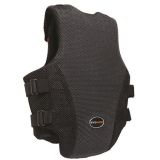Key features and considerations for body protectors
2023-12-11
Body protectors, also known as body vests or safety vests, are protective gear worn by riders to reduce the risk of injury to the torso in the event of a fall or impact while horseback riding. These protective garments are designed to absorb and distribute impact energy, providing an additional layer of safety for riders. Here are key features and considerations for body protectors:
Key Features:
1. Construction:
- Body protectors are typically constructed with multiple layers of impact-absorbing foam or other protective materials. The layers work together to reduce the force of impact on the rider's torso.
2. Materials:
- The outer shell of body protectors is often made of durable and abrasion-resistant materials, such as nylon or polyester. The inner layers may include foam panels, often made of materials like expanded polyethylene (EPE) or memory foam.
3. Adjustable Straps:
- Most body protectors have adjustable straps or fastening systems to allow riders to customize the fit for comfort and security.
4. Front and Back Coverage:
- Body protectors typically provide coverage for the front and back of the torso, including the chest, ribs, and spine.
5. Certifications:
- Reputable body protectors are certified to meet safety standards established by equestrian organizations. Certification labels may indicate compliance with standards such as BETA (British Equestrian Trade Association) or CE.
6. Flexibility:
- While providing protection, modern body protectors are designed to be flexible to allow for freedom of movement. This ensures that riders can still move comfortably and effectively while wearing the protector.
7. Ventilation:
- Some body protectors incorporate ventilation features, such as perforations or breathable materials, to enhance airflow and prevent overheating.
Considerations:
1. Fit:
- The proper fit of a body protector is crucial for its effectiveness. It should snugly conform to the rider's body without restricting movement.
2. Certification Standards:
- Check that the body protector complies with relevant safety standards. Certification labels or markings should be visible on the product.
3. Discipline Requirements:
- Some equestrian disciplines, especially in certain competitive events, may have specific requirements regarding the use of body protectors. Be aware of any rules or regulations applicable to your chosen discipline.
4. Maintenance:
- Regularly inspect the body protector for signs of wear or damage. Avoid using a damaged protector, and replace it if it has been involved in a significant impact.
5. Layering:
- Consider how the body protector fits over other riding apparel, such as show jackets. Some riders choose models that accommodate layering while others may prefer a slim design.
6. Usage:
- Body protectors are commonly used in disciplines such as eventing and cross-country riding, where the risk of falls and impacts is higher. However, riders in other disciplines may choose to wear them for added safety.
7. Comfort:
- Choose a body protector that is comfortable to wear for extended periods. Features like adjustable straps and ventilation contribute to overall comfort.
Body protectors are an important safety accessory for riders, especially those engaged in activities with an increased risk of falls or impacts. They provide an additional layer of protection for the torso, reducing the risk of serious injury in the event of an accident. Always follow the manufacturer's guidelines for proper use and care of the body protector.



